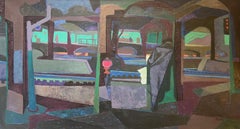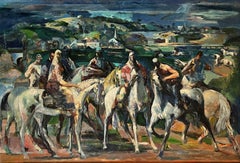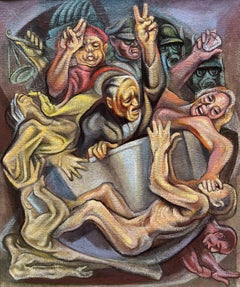Want more images or videos?
Request additional images or videos from the seller
1 of 5
Edward BibermanThe Landing/Dawn Landing
About the Item
- Creator:Edward Biberman (1904 - 1986)
- Dimensions:Height: 20 in (50.8 cm)Width: 30 in (76.2 cm)
- Medium:
- Movement & Style:
- Period:
- Condition:
- Gallery Location:Los Angeles, CA
- Reference Number:1stDibs: LU1859214281152
About the Seller
5.0
Gold Seller
Premium sellers maintaining a 4.3+ rating and 24-hour response times
1stDibs seller since 2022
17 sales on 1stDibs
Authenticity Guarantee
In the unlikely event there’s an issue with an item’s authenticity, contact us within 1 year for a full refund. DetailsMoney-Back Guarantee
If your item is not as described, is damaged in transit, or does not arrive, contact us within 7 days for a full refund. Details24-Hour Cancellation
You have a 24-hour grace period in which to reconsider your purchase, with no questions asked.Vetted Professional Sellers
Our world-class sellers must adhere to strict standards for service and quality, maintaining the integrity of our listings.Price-Match Guarantee
If you find that a seller listed the same item for a lower price elsewhere, we’ll match it.Trusted Global Delivery
Our best-in-class carrier network provides specialized shipping options worldwide, including custom delivery.You May Also Like
Mother and Child -- 1949
By Byron Browne
Located in Mc Lean, VA
Bryon Browne was an important American modernist painter.
Signed upper right; signed, dated and situated 'New York' on reverse
Category
1940s American Modern Figurative Paintings
Materials
Canvas, Oil
The Artist's Wife oil painting by Hans Burkhardt
By Hans Burkhardt
Located in Hudson, NY
Hans Burkhardt
The Artist's Wife (1930)
Oil on canvas, 20" x 16"
24" x 20 ½" x 1 ½" framed
Dated 1930 lower right recto. Annotated "To Elsa HB Louise Burkhardt 1930. HB" verso.
...
Category
1930s American Modern Nude Paintings
Materials
Canvas, Oil
Fish Story oil painting by Williams Charles Palmer
Located in Hudson, NY
This painting is illustrated in the Catalogue of the 1945 Encyclopedia Britannica Collection of Contemporary American Painting, p.84. Written and edited by Grace Pagano.
"Painting ...
Category
Mid-20th Century American Modern Figurative Paintings
Materials
Canvas, Oil
$7,500
H 30 in W 36 in
I'll Be There
Located in Lexington, MA
“I’ll Be There” by Craig Greene is a compelling 20 x 16 inch oil on canvas that captures quiet strength, emotion, and human connection through a modern figurative lens. Executed in G...
Category
2010s American Modern Figurative Paintings
Materials
Canvas, Oil
Carry me away
Located in Lexington, MA
“Carry Me Away” is a 24 x 20 inch oil painting by contemporary artist Craig Greene, blending figurative portraiture with abstract expression. This emotionally charged work features a...
Category
2010s American Modern Figurative Paintings
Materials
Canvas, Oil
FIRE
By Martin Mull
Located in New York, NY
Martin Mull is a singular artist whose iconography directly translate the American culture.
Category
21st Century and Contemporary American Modern Figurative Paintings
Materials
Oil, Canvas
The Lure of Real Estate
By Martin Mull
Located in New York, NY
Martin Mull is a singular artist whose iconography directly translate the American culture.
Category
21st Century and Contemporary American Modern Figurative Paintings
Materials
Canvas, Oil
Ladies In Waiting
By Martin Mull
Located in New York, NY
Martin Mull is a singular artist whose iconography directly translate the American culture.
Category
21st Century and Contemporary American Modern Figurative Paintings
Materials
Canvas, Oil
Lost Sheep
By Martin Mull
Located in New York, NY
Martin Mull is a singular artist whose iconography directly translate the American culture.
Category
21st Century and Contemporary American Modern Figurative Paintings
Materials
Canvas, Oil
On the Beach. Woman Reading. Mid-Century Chicago Modernist Oil Painting.
Located in Marco Island, FL
Chicago Modernist, William Schwartz, painted this intimate painting of a woman reading titled On the Beach. He studied at the Art Institute of Chicago shortly after emigrating to th...
Category
Mid-20th Century American Modern Figurative Paintings
Materials
Canvas, Oil, Board
$6,500
H 21.88 in W 17.38 in D 2 in
More From This Seller
View AllUntitled (Elevated Platform)
Located in Los Angeles, CA
This painting is part of our current exhibition - America Coast to Coast: Artists of the 1940s
Untitled (Elevated Platform), 1950, oil on canvas, signed and dated lower right, 30 x...
Category
1950s American Modern Paintings
Materials
Canvas, Oil
Riders of Pigeon Hill
By Jon Corbino
Located in Los Angeles, CA
Riders of Pigeon Hill, c. 1940s, oil on canvas, signed lower right, 24 x 36 inches, label verso with title, artist’s name and address; same information inscribed verso; ex-collection...
Category
1940s American Modern Paintings
Materials
Canvas, Oil
The Demagogue or Tale in a Tub
Located in Los Angeles, CA
The Demagogue or Tale in a Tub, 1952, oil on canvas, 24 x 20 inches, signed, titled, and dated verso, presented in a newer frame
The Demagogue is an iconic Bendor Mark painting fro...
Category
1950s American Modern Figurative Paintings
Materials
Canvas, Oil
Judy and Rita on Porch at Afton
Located in Los Angeles, CA
Judy and Rita on Porch at Afton, c. 1936, oil on canvas, 24 x 36 inches, title inscribed on tacking margin; “Judy” and “Rita” inscribed verso, NB: purchased together with The New Roa...
Category
1930s American Modern Figurative Paintings
Materials
Canvas, Oil
RFD#1
By Dale Nichols
Located in Los Angeles, CA
RFD #1, 1937, oil on canvas, signed and dated lower right, titled verso, 24 x 30 inches
Iowa had Grant Wood. Missouri had Thomas Hart Benton. Kansas had John Steuart Curry. And, Neb...
Category
1930s American Modern Landscape Paintings
Materials
Oil, Canvas
$75,000
Six O'Clock
Located in Los Angeles, CA
Six O-Clock, c. 1942, oil on canvas, 30 x 20 inches, signed and titled several times verso of frame and stretcher (perhaps by another hand), marked “Rehn” several times on frame (for the Frank K. M. Rehn Galleries in New York City, who represented Craig at the time); Exhibited: 1) 18th Biennial Exhibition of Contemporary American Oil Paintings from March 21 to May 2, 1943 at The Corcoran Gallery of Art in Washington, D.C. #87, original price $450 (per catalog) (exhibition label verso), 2) Craig’s one-man show at the Frank K. M. Rehn Galleries, New York City, from October 26 to November 14, 1942, #10 (original price listed as $350); and 3) Exhibition of thirty paintings sponsored by the Harrisburg Art Association at the State Museum of Pennsylvania in Harrisburg in March, 1944 (concerning this exhibit, Penelope Redd of The Evening News (Harrisburg, Pennsylvania) wrote: “Other paintings that have overtones of superrealism inherent in the subjects include Tom Craig’s California nocturne, ‘Six O’Clock,’ two figures moving through the twilight . . . .” March 6, 1944, p. 13); another label verso from The Museum of Art of Toledo (Ohio): original frame: Provenance includes George Stern Gallery, Los Angeles, CA
About the Painting
Long before Chris Burden’s iconic installation outside of the Los Angeles County Museum of Art, Urban Light, another artist, Tom Craig, made Southern California streetlights the subject of one of his early 1940s paintings. Consisting of dozens of recycled streetlights from the 1920s and 1930s forming a classical colonnade at the museum’s entrance, Burden’s Urban Light has become a symbol of Los Angeles. For Burden, the streetlights represent what constitutes an advanced society, something “safe after dark and beautiful to behold.” It seems that Craig is playing on the same theme in Six O-Clock. Although we see two hunched figures trudging along the sidewalk at the end of a long day, the real stars of this painting are the streetlights which brighten the twilight and silhouette another iconic symbol of Los Angeles, the palm trees in the distance. Mountains in the background and the distant view of a suburban neighborhood join the streetlights and palm trees as classic subject matter for a California Scene painting, but Craig gives us a twist by depicting the scene not as a sun-drenched natural expanse. Rather, Craig uses thin layers of oil paint, mimicking the watercolor technique for which he is most famous, to show us the twinkling beauty of manmade light and the safety it affords. Although Southern California is a land of natural wonders, the interventions of humanity are already everywhere in Los Angeles and as one critic noted, the resulting painting has an air of “superrealism.”
About the Artist
Thomas Theodore Craig was a well-known fixture in the Southern California art scene. He was born in Upland California. Craig graduated with a degree in botany from Pomona College and studied painting at Pamona and the Chouinard Art School with Stanton MacDonald-Wright and Barse Miller among others. He became close friends with fellow artist Milford Zornes...
Category
1940s American Modern Landscape Paintings
Materials
Canvas, Oil
$12,500
Recently Viewed
View AllMore Ways To Browse
Village Oil Painting
Still Life With Fruits Painting
Antique Unframed Canvas Paintings
Flower Vase Oil On Canvas
French Floral Still Life Painting
Art Medal
Art Medals
Mid Century Expressionist Art
Narrative Painting
Oil Paintings Of Nude Woman
Autumn Oil Paintings
Impressionist Seascape Painting
French Impressionist Framed Art
Montreal Canada
19th Century Paintings Of Children
Black And White Line Drawing
Baltimore Art
Emotional Paintings


